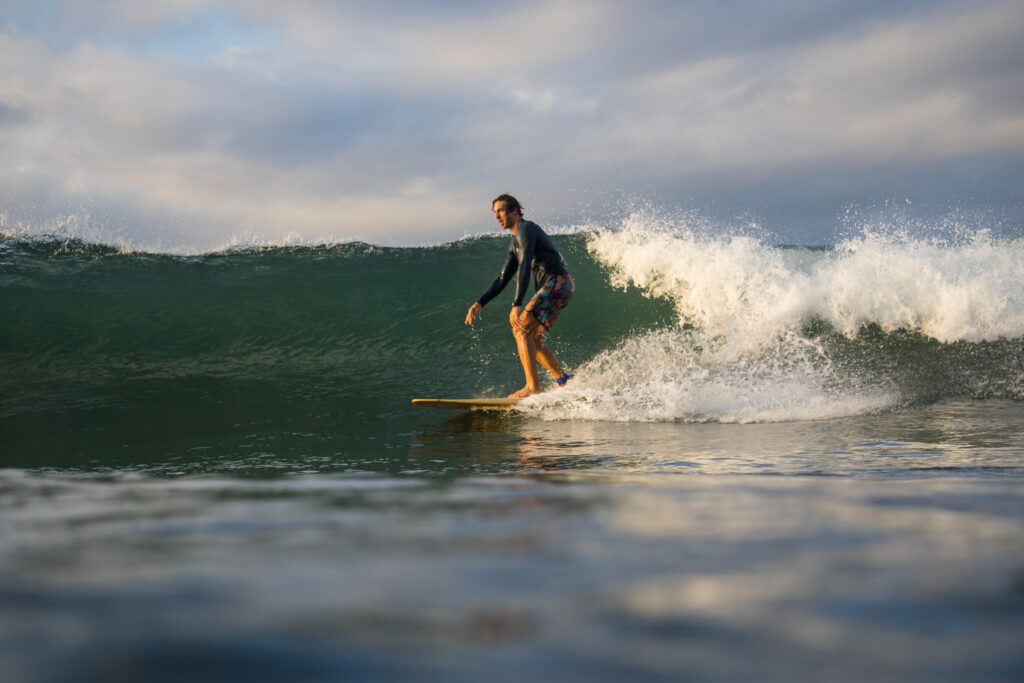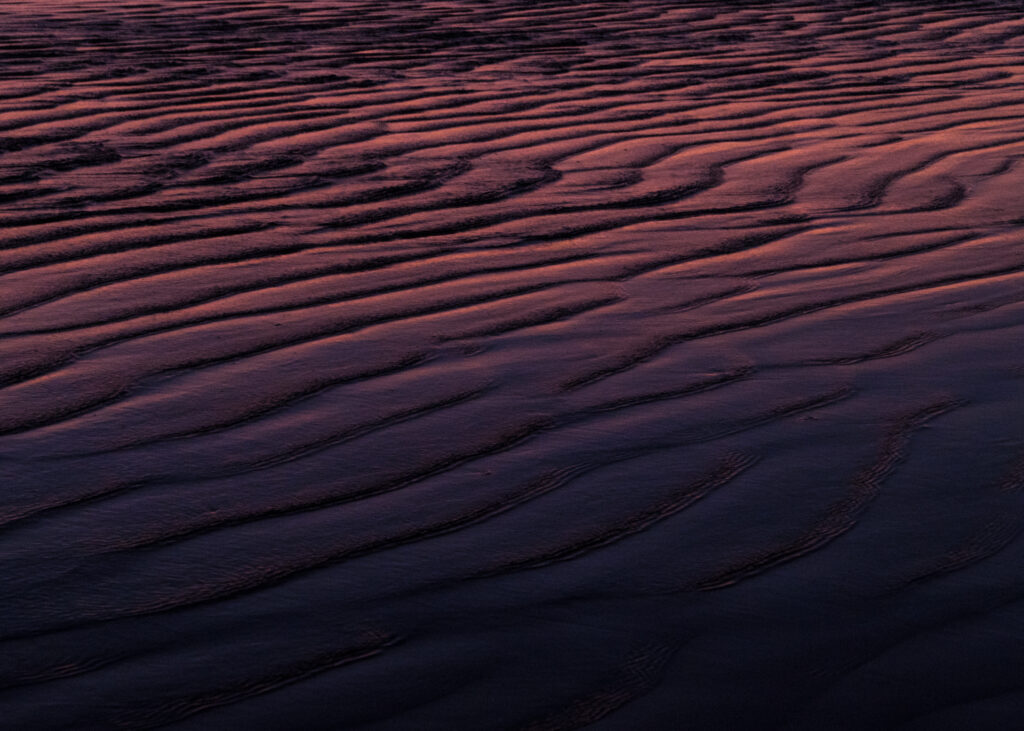Throughout the years teaching people how to surf here at Bodhi Surf + Yoga, we’ve pretty much seen it all.
We’ve watched people fall deeply in love with the ocean, and we’ve witnessed people fall back in love with themselves through the spiritual connection they find through surfing.
It’s because of this, that we absolutely cannot go through a single surfing lesson without talking about surf etiquette.
Practicing good surf etiquette and following the unwritten laws and rules ensures all of our students, as well as the other surfers around them, are able to have this deeply spiritual experience, uninterrupted.
In this blog, we’ll walk you through every single rule and etiquette that we teach our surf students, so you too can have, no — feel, this experience.
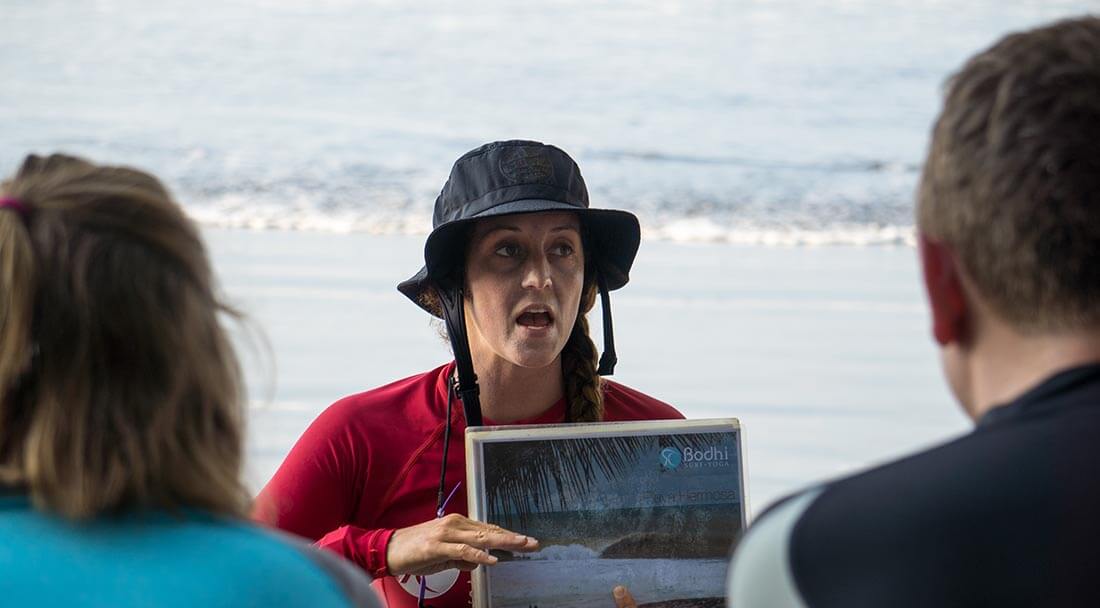
Why are there rules in surfing?
We get it — you’re on a surfing trip in Costa Rica, the last thing you want to hear about is rules.
We wish we could say with surfing there are none, but the fact of the matter is that there is common etiquette and basic rules that exist, only to ensure you enjoy surfing and have a successful experience.
At Bodhi Surf + Yoga, a huge part of our lessons is surfing etiquette. Essentially, these are the dos and don’ts for when you’re out on the water, and apply to when you’re:
- Paddling out
- Out on the line up
- Riding a wave
- Leaving the beach
Practicing the surfing etiquette not only ensures you’re able to have the best experience possible, whether a beginner surfer or advanced, but in doing so you’re also being mindful of the other surfers around you.
You wouldn’t believe how beneficial it can be to make friends out on the water (we’ll talk about this in a bit).
Long story short, although there is no mediator, surfing does have rules and etiquettes that are definitely worth knowing. They are important for your enjoyment, safety, and your reputation as a surfer.
And now for the long story!
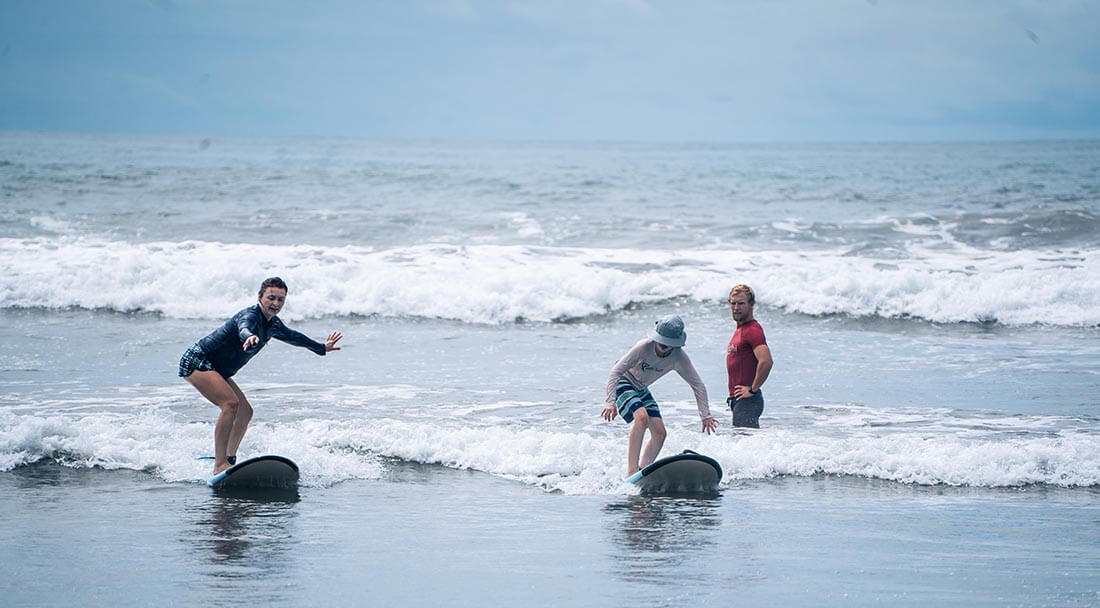
Right of way — the golden rule of surfing
One of the first things we teach our students at Bodhi Surf + Yoga is surfing’s golden rule — the right of way.
Why?
Understanding the right of way is central to most other rules of etiquette we’ll share here.
Understand the right of way, everything else here will be easier and you’re one step closer to being a well —educated surfer.
Who has the right of way?
The right of way belongs to the surfer with priority on the wave and can be determined in a few ways. Primarily, the right of way goes to the surfer:
- Closest surfer to the peak (where the wave is breaking) because they are in the optimal position to catch the wave and get to their feet first
- Surfer furthest out, as they have most likely been waiting the longest
If you have the right of way, the expectation is that you’re able to surf as long as you can on that wave without getting dropped in on. Basically, obeying the right of way prevents a complete free —for —all out in the line up.
For beginner surfers it ensures you get a chance to catch a wave, and for advanced surfers it prevents getting dropped in on by newbies.
The challenge of right of way
It can be difficult to determine which surfer has the right of way
We think it’s important to recognise that understanding the surfing etiquette will make you a better surfer, but not a perfect surfer.
You will definitely find yourself in situations where you really just don’t have a clue which surfer has the right of way — trust us, we see it a lot.
And this is ok! Sometimes the conditions will give you a really hard time.
In very choppy and rough conditions the sets can be packed with waves coming right after each other, with some forming just right in front of you. Now imagine these conditions in an already crowded line up, sounds hectic right?
With all of these waves and other surfers, it can get overwhelming and you may find difficulty in deciding if you have the green light to go for a wave or not.
There may even be another surfer near you in a better position to catch a wave, but you cannot see them because of the rough conditions impairing your vision.
This may lead you to paddle for and ride the wave that there is already another surfer riding. This is known as dropping in, another golden rule, which we’ll talk about next!
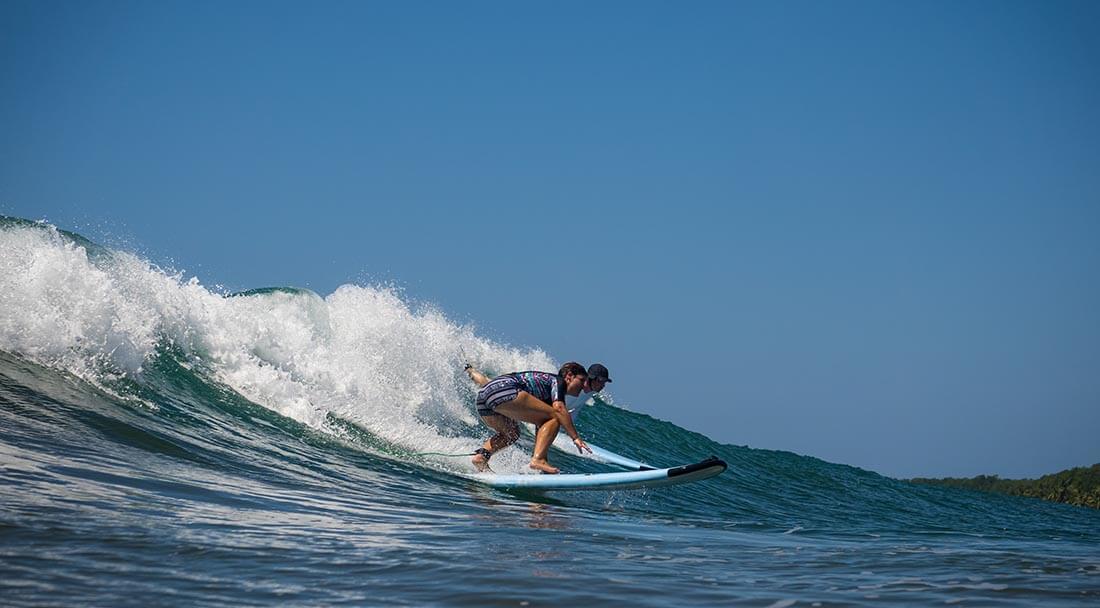
Dropping in: the first rule of surf etiquette
Dropping in can happen as a result of not obeying the right of way, which since giving over 1,000 surf lessons over the years, we’ve seen a lot of.
And trust us when we say this, being dropped in on is not often greeted with a smile.
Because of this, we don’t want our students being dropped in on tarnishing their experience, nor do we want them doing it to others!
What is dropping in?
This basically occurs when a surfer on the shoulder (furthest away from the peak) paddles for a wave that another surfer has priority on and attempts to catch that wave.
Generally, if someone can get to their feet before you it’s because:
- They are closer to where the wave is breaking
- They have the right of way
- It is their wave to catch
An attempt by another surfer to catch this wave while the other surfer is still on it is dropping in, and will all but impress the others in the line up.
Dropping in out on the line up
Imagine you’ve paddled out, fought your way through some pretty intense sets, and have waited your turn for a blue wave.
You’ve spotted one out on the horizon and tracked it. You paddle for it. This wave is almost yours, you’ve worked for it!
As you’re getting to your feet another surfer swoops in from further away from the peak and catches the same wave. This other surfer has dropped in on you, endangering you both!
When dropping is in OK
Sometimes dropping in can be acceptable
Believe it or not, as much as we discourage dropping in at our surf camps, there are situations where it is actually ok to do so.
A lot of the time surfers catching blue/green waves out in the line up won’t catch a wave all the way to its completion. In other terms, after the wave has broken, it is not uncommon to abandon it and head back into position in the line up.
So what happens to this wave once the surfer with priority has abandoned it?
In this situation, the next surfer with the right of way has every right to catch the remainder of that same wave, most likely in the white water.
Can experienced surfers drop in on beginners?
There’s no simple straightforward answer to this. On one hand, everyone is entitled to surf and deserves equal chances to be able to do so. On the other, not all waves are for everyone.
A lot of the time, advanced and experienced surfers will watch beginners out in the line up to judge their abilities. They’ll then use this knowledge in the line up to decide whether or not the beginner surfer with the right of way will be able to catch a specific wave or not.
If they think not, then the experienced surfer may drop in and catch the same wave. However, if the beginner surfer does paddle and catch the wave, the other surfer must abandon it.
As a beginner, it is perfectly fine to give up a wave that you have priority on to a more experienced surfer. You’ll have other chances to catch waves more suited to your experience level.
There are plenty more waves in the sea!
What to do if you get dropped in on
We’ll be honest, at some point while surfing it is likely that you’ll get dropped in on. It happens and you don’t always have control over it, but what you can control is how you handle it.
If you are dropped in on, don’t be too quick to give the other surfer an earache. They might be a beginner surfer or in a surf camp, and really didn’t mean to do it.
The best way to stop a surfer dropping in on another surfer again is to educate them on the common surfing etiquette.
You can give a friendly shout to the other surfer, maybe a “hey dude/dudette!” or something like that. They should then stop paddling and abandon the wave so you can catch it.
Afterwards you can give them a little heads up on what they’ve done and explain briefly how they can avoid doing it again, and that after the surf session they owe you a cold one (worth a try!)
What to do if you drop in on other surfers
First of all, don’t panic.
Depending on where you are, a lot of local surfers can be really understanding towards first-time surfers that mistakenly drop in, especially those who are in lessons or surf camps.
If you find yourself in the situation where you’ve dropped in on another surfer, here’s what to do:
- Stop paddling for the wave
- If you’re already riding a wave, your next best option is to abandon it
- Give a quick apology to the surfer you’ve dropped in on. “My bad bro!” should suffice
- Head back into the line up and try again
Snaking: the biggest example of poor surf etiquette
Another move that we can’t stand to see is snaking — a huge don’t in the surfing world.
This occurs when one surfer back paddles another to get priority on the wave and in doing so, essentially positions themselves to have priority on the wave at the last second.
Snaking typically occurs in these steps:
- It starts with one surfer closest to the peak and another further away out on the shoulder
- The surfer further out paddles just behind the surfer in position to catch the wave
- This surfer is now in the right of way position, and has stolen priority on the wave
What does snaking look like?
To give you an idea of what this might look like out on the line up, think of a wave that is breaking to the right. There is a surfer positioned nearest to the peak, giving them the right of way, and another surfer further out on the shoulder paddles towards the peak just behind them.
This surfer is now closer to the peak than the original surfer, and is now technically positioned to have priority on the wave.
So what happens next? Well, aside from being extremely annoying, snaking can be dangerous.
If one surfer snakes behind the other with the right of way and they both catch the same wave, this can lead to a collision — risking both surfers and others around them.
Also, it will cause a good wave to go to waste.
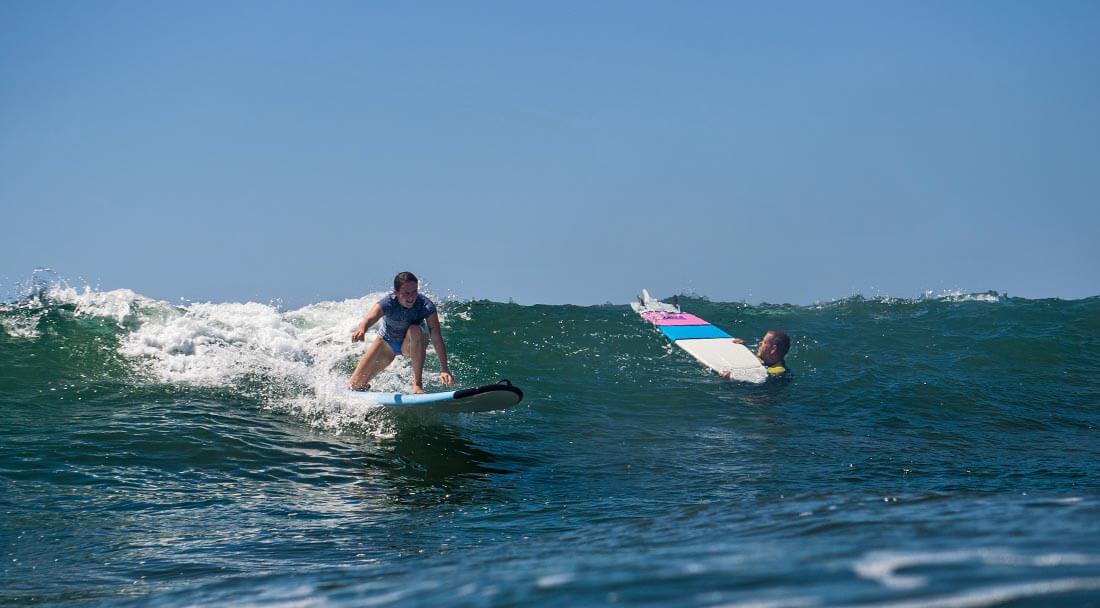
Avoid being an obstacle
Being an obstacle to other surfers, aside from dropping in and snaking, can occur without you even realizing. While paddling out to reach the line up, it is important that you are aware of your position and direction, so you don’t head directly into the direction of oncoming surfers.
How to stay out of the way when paddling out
In our surf camps, we usually teach our students a few ways to avoid being an obstacle. Luckily, it doesn’t take much:
- Start paddling out where it is uncrowded
- Don’t paddle in the direction of oncoming surfers
- Once you’ve passed through the surf zone you can then head towards the line up
Before you start paddling out, we recommend that you take a few minutes just to watch the surfers out in the line up and to observe which way the waves are typically breaking.
This allows you to get an idea of where you should start to paddle out and in which direction.
For example, if a surfer is on the wave and it’s breaking towards their left, you should paddle towards your left (in the opposite direction). The surfer will ride the blue/green part of the wave, so will therefore surf in the direction of the breaking wave, and you should paddle in the direction of the white water where the wave has already broken.
This prevents you ruining the blue/green face of the wave for the surfer, as well as getting in their way.
Your surfboard can be an obstacle too!
Being an obstacle doesn’t just mean your body being in the way — it can also be your surfboard.
Even if you are attached to your surfboard with a leash, never ditch your surfboard or let it go when a large wave is bearing down on you.
It can still float a fair distance and therefore get in the way of other surfers and act as a dangerous obstacle.
Rather than ditching your board when approaching an oncoming wave, you can:
- Duck dive — push your surfboard underwater and dive with it underneath the wave
- Turtle roll — roll over underneath your board, gripping the rails as the wave goes over
- Plank the wave — position yourself on your board in a plank, allowing the wave to go between your body and the top of the surfboard
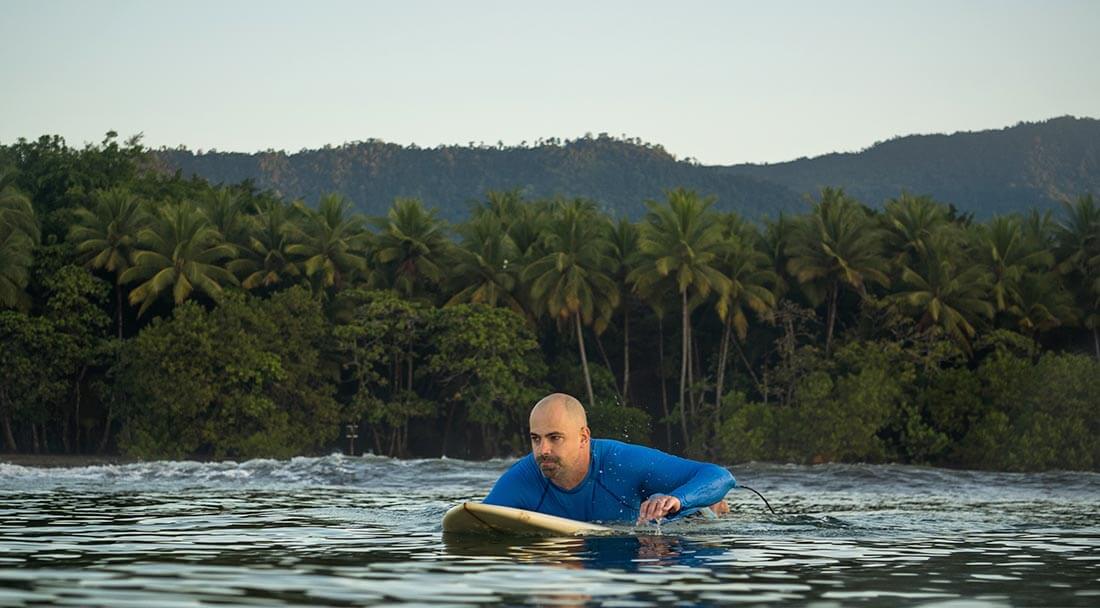
Keep a low profile
Essentially, keeping a low profile involves remembering and respecting that there are most likely others around you that want to surf too, both beginner and advanced.
With this in mind, at Bodhi Surf + Yoga we believe that the ocean is for everyone, and that we all deserve to experience connection and fulfillment through surfing.
Let waves go
A part of accepting that the ocean is for everyone is sharing waves. You may have just caught three waves in a row, so maybe let the next set go to the others who are surfing near you.
Remember, everyone’s there to catch a few waves.
Catching all the waves possible may seem really cool and fulfilling, but you really don’t want to be remembered as a wave hog. If you’re a more advanced surfer surfing with beginners, they’ll undoubtedly appreciate your sharing.
Practice surf etiquette by respecting the locals
Respecting the locals of an area is possibly one of the most important things you can learn as a surfer.
Everyone is entitled to surf and catch waves, but you must be mindful of the fact that there are locals who surf there every day and they know the location best.
Trust us, if ever you want to make friends while surfing, let it be the locals of the area. Surfing communities can be extremely supportive of each other — being respectful, keeping a low profile, and practicing etiquette surfing will earn you respect amongst the local surfers.
Making friends out on the water and getting in good with the area’s locals can completely change your surfing experience:
- You might get to experience wave sharing! Also known here at Bodhi Surf + Yoga as party waves — you and a buddy get to race each other on the same wave
- People will be much more forgiving of your newbie mistakes
- Locals may be more lenient towards mistake drop ins
- You’ll experience such a supportive atmosphere — surfing has cheering and celebrations too!
- They may invite you back for future surf sessions
How to create this relationship with locals
So how do you achieve this?
Be humble.
This means accepting the fact that you don’t know everything and that the other surfers around you may be better and more experienced. Learning the dos and don’ts of surfing takes time.
This is why we believe so strongly in taking a few surfing lessons. This shows locals that you:
- Are making an effort to learn to surf- not just showing up assuming that you know everything
- Know your level — there’s nothing worse than a beginner that thinks they’re professional!
- Take value in surfing– you are willing to pay to learn about this activity and want to learn it properly
What we always say here at Bodhi Surf + Yoga is that ‘you don’t know what you don’t know’! Even after years and years of surfing experience, we’re still learning every day!
Remaining humble and conscious of your surfing level will certainly get you invited back to local surfing spots!
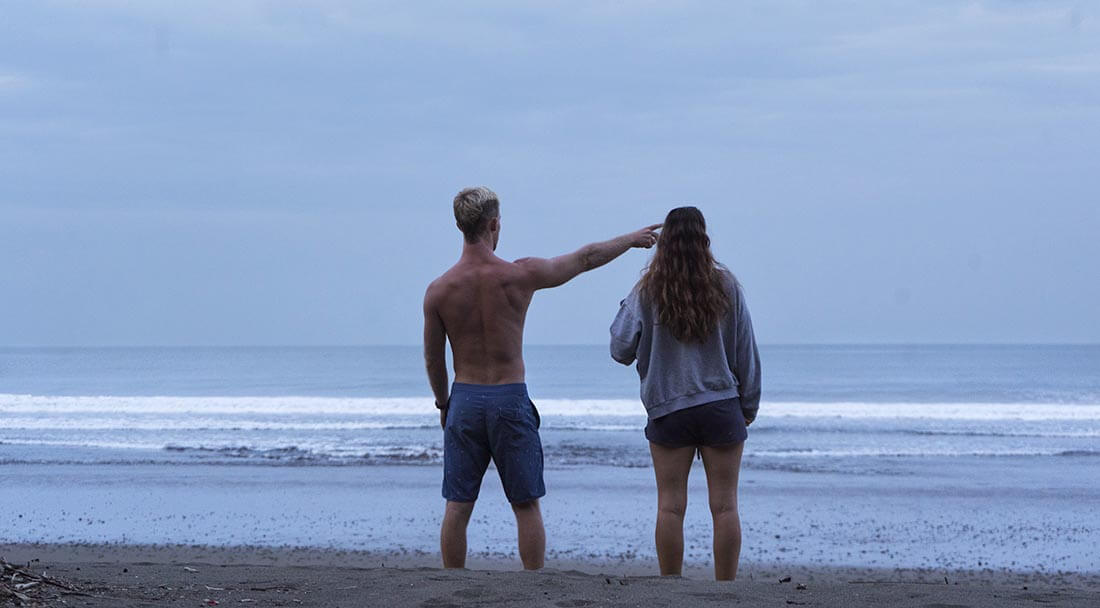
Talking to the locals
Even more so than checking online surf reports, it is also extremely beneficial for visiting surfers to talk to the locals. Again, this shows that you are making an effort to be respectful of their area.
You might be thinking, ‘so what am I supposed to say to them?!’
Ask them about the conditions — they see it every day!
They know better than anyone. If you’re already at the location, ask about today’s:
- Waves
- Tides
- Currents
- Winds
Most of the time, locals will be more than happy to point you in the direction of some of the best surf spots in the area.
If you’re visiting a country that doesn’t speak your native language, you may want to have a few phrases in that language written down on your phone. Just a few basic ones:
- How are you?
- How are the waves?
- Can I surf here?
Again, you’re showing locals that you want to respect them and their area.
At Bodhi Surf + Yoga we often find our guests mingling with local surfers — we are very lucky here in Bahia Ballena to have warm waters, a relaxed lifestyle (Pura Vida!), bigger — more spread-out beaches, and not to mention some of the friendliest locals around!
Those are just a few good reasons to surf in Bahia Ballena, so we’d be stoked if you came and gave us a visit!
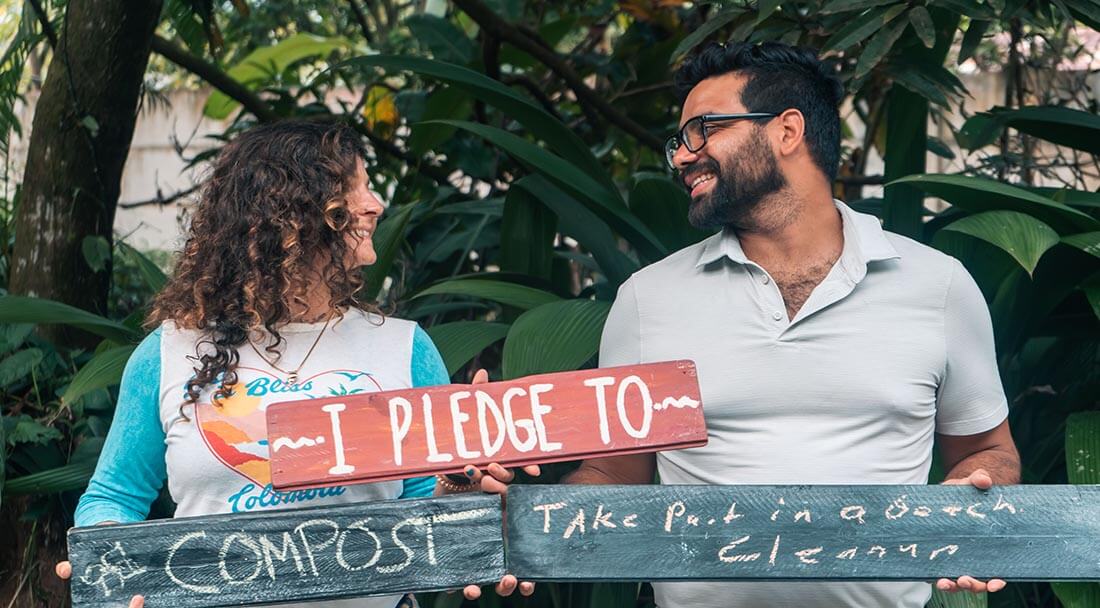
Protecting the environment is also good surf etiquette
As surfers, we have an immensely important responsibility to protect the ocean. Not only is it our surfing playground, but it is also an ecosystem — a home.
At Bodhi Surf + Yoga we integrate this responsibility into every single surf lesson that we do.
We’re not just teaching how to stand up on a wave, we’re also educating our guests about the surrounding reefs and marine life that we are so proud to have here in Costa Rica.
Being an ocean steward
Striving to protect the ocean ecosystem does not have to be overly scientific or difficult. You are already doing your part to protect the ocean by:
- Picking up your garbage
- Not tampering with the environment
- Not tampering with the animals
- Abiding by the park rules — e.g. no pets, no fishing, no barbecues, etc.
Essentially, leave no trace of your visit to the beach.
You can set yourself challenges and give yourself manageable goals. For example, how about picking up five pieces of trash every time you go to the beach?
Fall in love with surfing
For our surf instructors here at Bodhi Surf + Yoga, the thesis behind teaching people how to surf is biophilia — love of the ocean. We strongly believe that by learning how to surf, people will continue to surf, and develop a deep love with the ocean.
I mean, how could you not fall in love with this fascinating and mysteriously vast playground?
By falling in love with the ocean, it makes you want to protect it. You want to look after this resource that gives back so much joy, energy, and fulfillment.
By teaching people to surf, we like to believe that we are also teaching people to love the ocean, and therefore producing more ocean stewards every week.
In theory, by becoming passionate about surfing, you become passionate about the ocean.
This is why we believe so passionately in lessons. You can easily rent a surfboard for cheap and head out into the waves on your own, but you might be missing out on crucial information that allows you to truly gain that connection to the ocean.
After all, that’s what it’s all about, right?
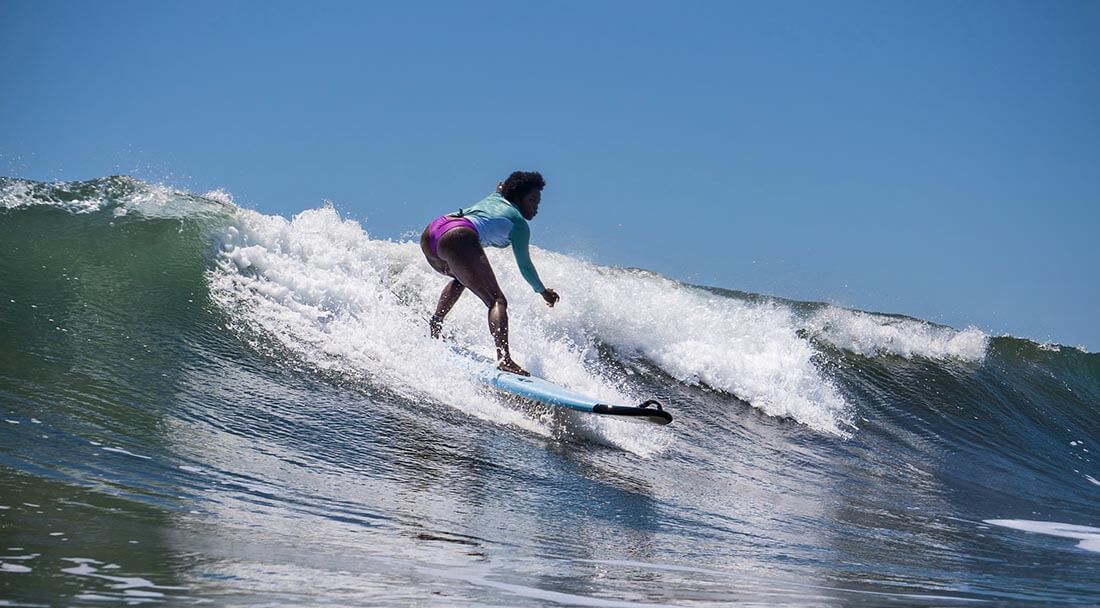
And that’s it for surf etiquette- time to go surfing!
It’s great to understand that surfing does have its own unwritten laws and rules, and it’s even better to know them!
Picking up a board and catching some amazing waves is just a small part of surfing.
Understanding the common etiquette is so important to your surfing experience, but also for the other surfers around you.
By following this guide, you are sure to be respected by other surfers and will no doubt end up with some pals out on the water.
The absolute last thing we want is for your first surfing experience to go wrong, because you got yourself into a bit of trouble by not knowing the surf etiquette. We want you to fall in love with surfing!

For First-Time Surfers
You Don't Need Experience. You Don't Need Gear. You Just Need This.
Our free 5-day email course that reveals the 5 myths keeping beginners at "I'm not ready" instead of catching their first wave and finding inner peace-and how to overcome them fast.
Change the heading on the Separator tab ->
Search
The Newbie Surf + Yoga Camp Kickstarter
Bust the 5 biggest myths about going to a surf and yoga camp so you can stop procrastinating and start catching waves - with our FREE 5-day email course.
Change the heading on the Separator tab ->
Most Read Blogs
What is the Meaning of Anjali Mudra?
May 27, 2020
Fitness for Surfers: Workouts, Exercises & Training
February 10, 2022
The Best Places to Eat in Uvita, Costa Rica
May 19, 2022
How to Get From SJO to Costa Ballena, Costa Rica
May 31, 2018
Change the heading on the Separator tab ->
Categories
Categories
- Bodysurfing (5)
- Food (7)
- Responsible Business (6)
- Surfing (66)
- Travel (65)
- Yoga (43)
Change the heading on the Separator tab ->
Newsletter
Thanks for subscribing! Please check your email for further instructions.
Change the heading on the Separator tab ->
Follow Us
George Frost
Change the heading on the Separator tab ->
Read more
5 Reasons Why a Surf + Yoga Retreat Should Be Your Next Big Bucket List Adventure
Words by Travis
If you’re reading this, chances are you’re experiencing a little restlessness. You’ve scrolled past the passive beach vacations and you know, deep down, that your next trip needs to be different. It…
Small Things That Make A Big Difference to Progressing Your Surfing
Words by Guest Post
Welcome to the first of our three-part series covering the small things that make a big difference to your surfing! You are most likely reading this because you’ve taken some surf lessons…
Sandbars for Surfers: Everything You Need to Know and More
Words by Guest Post
Ever wonder what a sandbar is? When it’s low tide you can see them, but what happens when the ocean covers them? Most surfers may just look at the waves on the…


